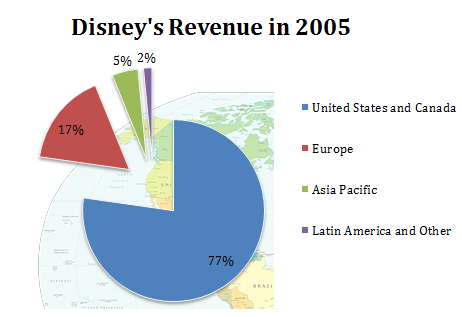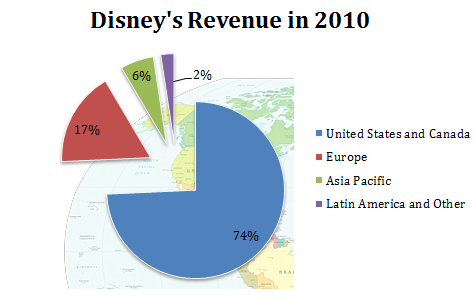Disney: Looking at the International Opportunity
In today's world, most companies span several regions and sell across the world. As Foolish colleague Morgan Housel notes, 10 years ago, less than a third of S&P 500 revenue came from overseas. Today, more than half of the S&P 500's growth comes from overseas.
And that number is growing. The truth is, investors regularly underestimate how much demand comes from abroad. More importantly, for large, multinational corporations that have already established a presence in their home markets, much of their future growth comes from abroad.
With that in mind, today we're looking at Walt Disney (NYS: DIS) . We'll examine not only where its sales and earnings come from, but how its sales abroad have changed over time.
Where Disney's sales were five years ago
Five years ago, the United States and Canada saw 77% of Disney's sales.

Source: S&P CapitalIQ.
Where Disney's sales are today
Today, the United States and Canada still provide the lion's share of Disney's sales, but other markets are showing progress in contributing to the company's sales haul.

Source: S&P CapitalIQ.
Much of Disney's growth comes from its media networks segment which includes popular broadcasters such as ABC and ESPN. That segment is helping drive results in the United States. Still, growth in emerging markets -- while growing from a smaller base -- has been impressive over the past five years.
Segment | 5-Year Revenue Growth |
|---|---|
United States and Canada | 17% |
Europe | 26% |
Asia Pacific | 60% |
Latin America and Other | 90% |
S&P CapitalIQ.
While theme parks are only just about 28% of Disney's total revenues, the opening of Hong Kong Disney in 2005 and the planned Shanghai resort both illustrate the company's commitment to expanding its brand within China.
Competitor checkup
One last point to check is how Disney's footprint compares to some of its peers:
Company | Geography With Most Sales | Percent of Sales |
|---|---|---|
Disney | United States and Canada | 74% |
Carnival (NYS: CCL) | North America | 52% |
CBS (NYS: CBS) | United States | 85% |
Marriott* (NYS: MAR) | North America* | 62% |
Source: S&P CapitalIQ. * Percent of non-luxury and timeshare segments.
Finding peers for Disney is difficult, the company encompasses a unique mix of hospitality, media, and consumer merchandising. To get a cross section, here are three companies that each are competitors of Disney in a part of their business: Carnival, which competes with the company's cruise line; CBS as a competitor of its media networks category; and Marriott which is a hospitality peer.
Relative to this group, Disney has a slightly larger international skew. Like CBS, its media category is heavily tilted toward the United States, but its parks and resorts are increasingly focusing on international markets. If you're an investor in Disney, the large capital outlays and time associated with building out its ambitious plans in Shanghai (and expansion in Hong Kong) means the United States will continue driving results for the immediate future.
Keep searching
If you're looking to stay updated on Disney, or any other companies listed above, make sure to add them to our free watchlist service, My Watchlist. It's free, and it helps you constantly stay updated on news and analysis on your favorite companies.
Add Walt Disney to My Watchlist.
Add Marriott International to My Watchlist.
Add Carnival to My Watchlist.
Add CBS to My Watchlist.
At the time thisarticle was published Eric Bleeker owns shares of no companies listed above. You can follow him on Twitter to see all of his technology and market commentary. Motley Fool newsletter services have recommended buying shares of Walt Disney. Try any of our Foolish newsletter services free for 30 days. We Fools may not all hold the same opinions, but we all believe that considering a diverse range of insights makes us better investors. The Motley Fool has a disclosure policy.
Copyright © 1995 - 2011 The Motley Fool, LLC. All rights reserved. The Motley Fool has a disclosure policy.

